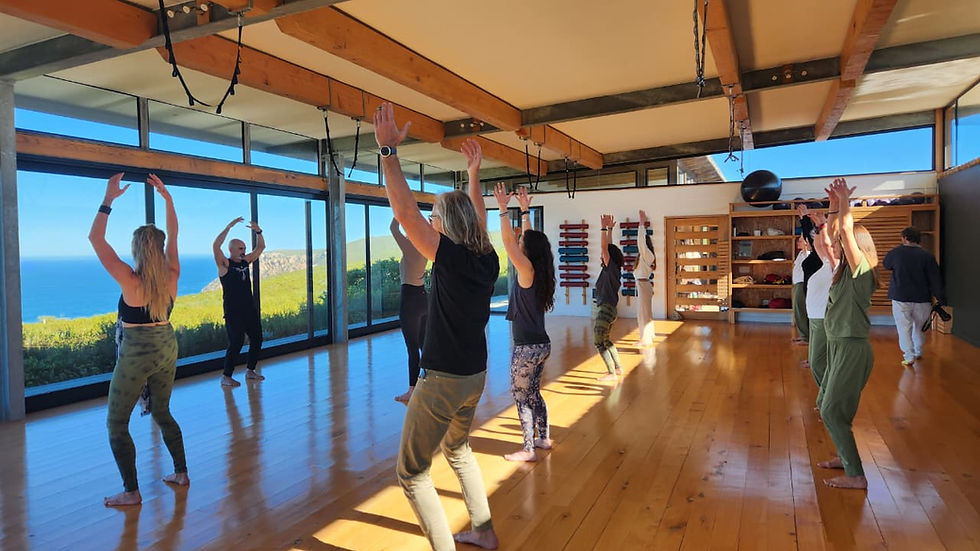Kundalini and Yin Yoga – How do they differ? By Atma O-Meara
- The Space Between
- Feb 9
- 4 min read
Updated: Feb 10

People have been asking me this question for quite a while: What are the biggest differences between Kundalini and Yin yoga?
Yoga has been my life path for a little over 50 years, 30 of which I have been teaching. These days there are a fantastic array of yoga styles being offered globally. Some of them endure throughout the decades, others, new to the yoga world, arrive with a bang and become the new hot favourite! Some literally change the face of classical Hatha yoga that has been around for a few thousand years. Yoga arrived in the Western world in the 1800’s when the first Indian gurus began to visit the USA and Europe.
I grew up in Kenya, one of the last remnants of the once mighty British Empire in East Africa. Back then, in the 1950’s, girls were either into sports or ballet. As I was shamefully hopeless at anything to do with hitting a ball, I assigned to ballet classes at the tender age of six. I had the great honour of learning ballet with an incredible Russian woman called Vera Zerkovitz, trained at famous Kirov Ballet School in St Petersburg, Russia. She was interned in Kenya during World War II. She opened her studio shortly after the war ended and was still teaching in Nairobi in her 90’s! “Madam” as she was called, instilled in me a lifelong love of movement and music.
Back in the 1960’s Kenya, no one had even heard of yoga, let alone teach it. It was only when I arrived in South Africa in 1967 that I experienced yoga, attending classes in the gentle Sivananda tradition. This was followed by many years of Iyengar yoga—to my mind the very best foundation a person can receive. However, I began to long for a yoga style that nourished me spiritually. Quite by chance, I was invited to attend a yoga class at a private home in Cape Town. The teacher was sharing something quite unlike the Hatha style I had been practicing for so long. It was called Kundalini. I wept with joy for most of the class—I had come home! That was back in 1998. In 2000 I joined the first teacher training in Cape Town. I was the first Kundalini teacher in the Western Cape of South Africa. In my enormous enthusiasm I was teaching 12 classes a week. I had just turned 52! As an end note to this story, I opened a yoga retreat centre called Little Samadhi in Barrydale, a pretty little town in the Little Karoo of South Africa. Here, I first heard about Yin yoga from an overseas visiting yogi. I fell in love again! 15 years down the line and being a bit of a yogic nomad, I have finally landed in the beautiful coastal town of Plettenberg Bay.
So what is the difference between Kundalini and Yin yoga? I can best describe it using the traditional Chinese concept of feminine and masculine, in other words Yin and Yang.
Yin yoga is a relative newcomer that slipped gracefully into awareness in the USA in the early 2000’s as the result of friendship and collaboration between three well established yoga teachers: Sarah Powers, Bernie Clarke and Paul Grilley. Their emphasis was focused on the deeper connective tissues including fascia, ligaments and joints. Stimulating these tissues became the focus of the asanas (postures). Placing gentle, sustained pressure on the joints and the deeper tissues in long-held poses allows them to stretch slowly. Stress (not the bad kind) is the tension we put on our tissues, whereas stretch is the elongation that results from the stretch, if that makes sense?
In addition to this, Yin yoga also works on an energetic level through incorporating the body’s meridians, known in yoga as the Nadis and in Traditional Chinese Medicine as Chi. Most of the practice takes place on the floor with the usual “props” of bolsters, blankets and blocks. Because the practice of Yin yoga is slow and meditative, one gains insight into all levels of consciousness: physical, mental, emotional. I might add that it can also be challenging to hold a pose for 3-5 minutes! The end result is stronger, more resilient joints and increased flexibility.
Kundalini yoga is the complete opposite to Yin Yoga. In other words, it is the yang or masculine end of the pole. Great emphasis is put on breathing techniques that harvest prana(the life force), as well as rhythmic, rapid movements that increase oxygen supply, circulation, nerve and muscular strength and mental focus. As well as this, there are a number of yogic techniques that aid general well-being. These includea deep dive into the chakras (energy centres), bandhas (body locks) and mudras (hand gestures) that create specific circuits in the nervous system and areas of the brain that activate energy flows. The other three aspects of the yoga are mantra (chanting) that help our minds to become one pointed, meditation (to learn how to master the mind by ridding it of our subconscious garbage) and finally music of an appropriate frequency to elevate our consciousness as well as helping us get through challenging exercises! The practice in its entirety is energising and elevating, awakening our consciousness to higher levels.
I hope this has given you a little insight into the wonderful world of Yoga! You can join my Kundalini and Yin classes at The Space Between to experience these two polarities for yourself.


